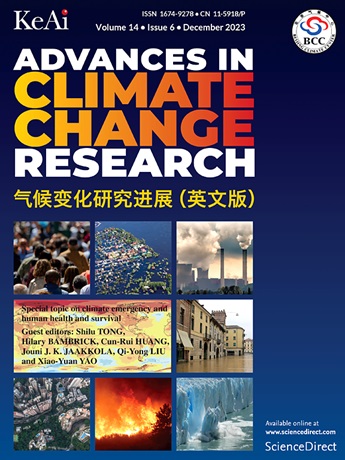Impact of modified parameterizations in CLM5.0 on soil hydrothermal dynamics in permafrost regions of the Qinghai–Tibet Plateau
IF 5.2
1区 地球科学
Q1 ENVIRONMENTAL SCIENCES
引用次数: 0
Abstract
Accurate understanding and modeling of soil hydrothermal dynamics in permafrost regions is essential for reliably assessing future permafrost changes and their impacts. However, the inadequate representation of soil water‒heat transport processes in current land surface models (LSMs) introduces large uncertainty in simulating permafrost dynamics, particularly on the Qinghai–Tibet Plateau (QTP). In this study, we modified the parameterizations of soil thermal conductivity, unfrozen water and soil evaporation resistance in version 5.0 of the Community Land Model (CLM5.0) and assessed their effects on soil hydrothermal dynamics in permafrost regions on the QTP using in-situ measurements at the depths of 10–40 cm. The results showed that soil temperature was more sensitive to the modified soil thermal conductivity and unfrozen water schemes, with average RMSE reduced by approximately 0.60 °C compared to the default CLM5.0. Soil moisture was mainly affected by the unfrozen water scheme during freezing and by the optimized soil evaporation resistance scheme during thawing, with maximum accuracy improvements of 8% and 25%, respectively. All three schemes significantly improved soil thermal conductivity simulations, reducing RMSE by over 80%. Overall, our modifications remarkably reduced simulation errors compared to the default schemes, improving the average accuracy of soil temperature, soil moisture and soil thermal conductivity by approximately 16%, 21% and 81% respectively. Additionally, this study emphasized the importance of accurately representing permafrost-related processes in LSMs, as they significantly affected simulation results. Specifically, soil thermodynamics is strongly sensitive to subtle changes in soil moisture transport processes, such as the hysteresis effect of unfrozen water content, and parameterizations of snowpack and vegetation. Therefore, future work should focus on enhancing the accurate representations of these processes and optimized parameters in LSMs to improve the simulation accuracy in permafrost regions on the QTP. This study enhanced the understanding of soil hydrothermal processes in LSMs and provided valuable insights for the future model development for permafrost regions under the context of climate change.
CLM5.0修正参数化对青藏高原多年冻土区土壤热液动力学的影响
准确理解和模拟多年冻土区土壤热液动力学对于可靠地评估未来多年冻土区的变化及其影响至关重要。然而,当前陆地表面模式(LSMs)对土壤水热输送过程的不充分表征,给模拟多年冻土动力学带来了很大的不确定性,特别是在青藏高原(QTP)。本研究对CLM5.0版本中土壤热导率、未冻水和土壤蒸发阻力的参数化进行了修正,利用10-40 cm深度的原位测量,评估了它们对多年冻土区土壤热液动力学对QTP的影响。结果表明,土壤温度对改良土壤导热系数和不冻水方案更为敏感,与默认CLM5.0相比,平均RMSE降低约0.60°C。土壤水分主要受冻结期未冻结水方案和解冻期土壤蒸发阻力优化方案的影响,精度分别提高8%和25%。这三种方案都显著改善了土壤热导率模拟,将RMSE降低了80%以上。总体而言,与默认方案相比,我们的修改显著降低了模拟误差,将土壤温度、土壤湿度和土壤导热系数的平均精度分别提高了约16%、21%和81%。此外,本研究强调了在LSMs中准确表示与永久冻土相关的过程的重要性,因为它们显著影响模拟结果。具体而言,土壤热力学对土壤水分输送过程的细微变化非常敏感,如未冻水含量的滞后效应、积雪和植被的参数化等。因此,未来的工作应侧重于提高这些过程在lsm中的准确表示和优化参数,以提高QTP上多年冻土区的模拟精度。该研究增强了对LSMs土壤热液过程的认识,并为未来气候变化背景下多年冻土区的模型开发提供了有价值的见解。
本文章由计算机程序翻译,如有差异,请以英文原文为准。
求助全文
约1分钟内获得全文
求助全文
来源期刊

Advances in Climate Change Research
Earth and Planetary Sciences-Atmospheric Science
CiteScore
9.80
自引率
4.10%
发文量
424
审稿时长
107 days
期刊介绍:
Advances in Climate Change Research publishes scientific research and analyses on climate change and the interactions of climate change with society. This journal encompasses basic science and economic, social, and policy research, including studies on mitigation and adaptation to climate change.
Advances in Climate Change Research attempts to promote research in climate change and provide an impetus for the application of research achievements in numerous aspects, such as socioeconomic sustainable development, responses to the adaptation and mitigation of climate change, diplomatic negotiations of climate and environment policies, and the protection and exploitation of natural resources.
 求助内容:
求助内容: 应助结果提醒方式:
应助结果提醒方式:


